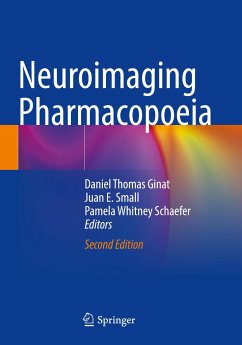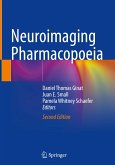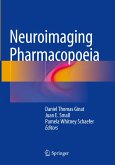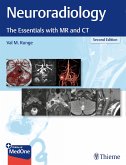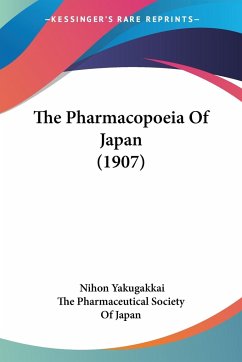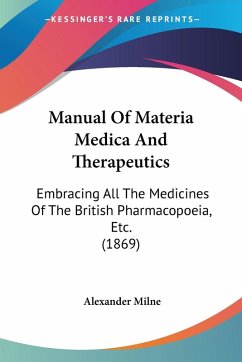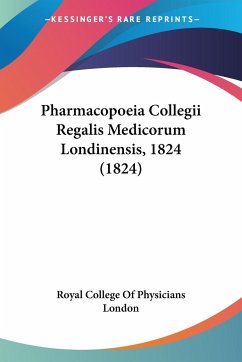Neuroimaging Pharmacopoeia
Herausgegeben:Ginat, Daniel Thomas; Small, Juan E.; Schaefer, Pamela Whitney
Neuroimaging Pharmacopoeia
Herausgegeben:Ginat, Daniel Thomas; Small, Juan E.; Schaefer, Pamela Whitney
- Broschiertes Buch
- Merkliste
- Auf die Merkliste
- Bewerten Bewerten
- Teilen
- Produkt teilen
- Produkterinnerung
- Produkterinnerung
This book, now in a revised and updated second edition, reviews the imaging-relevant features of selected classes of pharmaceuticals and drugs regarding CNS and head and neck images. The agents discussed belong to classes like Drugs and Alcohol; Contrast Agents; Chemotherapy; Immunotherapy; Antibiotics, Antiviral Agents, and Vaccines; Antiepilectic and Antipsychotic Agents; and Hematologic Agents, each of which is addressed in a separate chapter. The book's closing part addresses agents from various other classes.
For each class, concise texts and rich images review and illustrate the…mehr
Andere Kunden interessierten sich auch für
![Neuroimaging Pharmacopoeia Neuroimaging Pharmacopoeia]() Neuroimaging Pharmacopoeia164,99 €
Neuroimaging Pharmacopoeia164,99 €![Neuroimaging Pharmacopoeia Neuroimaging Pharmacopoeia]() Neuroimaging Pharmacopoeia75,99 €
Neuroimaging Pharmacopoeia75,99 €![Neuroradiology Neuroradiology]() Val M. RungeNeuroradiology77,99 €
Val M. RungeNeuroradiology77,99 €![The Organic Materia Medica Of The British Pharmacopoeia Systematically Arranged (1874) The Organic Materia Medica Of The British Pharmacopoeia Systematically Arranged (1874)]() William SouthallThe Organic Materia Medica Of The British Pharmacopoeia Systematically Arranged (1874)21,99 €
William SouthallThe Organic Materia Medica Of The British Pharmacopoeia Systematically Arranged (1874)21,99 €![The Pharmacopoeia Of Japan (1907) The Pharmacopoeia Of Japan (1907)]() Nihon YakugakkaiThe Pharmacopoeia Of Japan (1907)38,99 €
Nihon YakugakkaiThe Pharmacopoeia Of Japan (1907)38,99 €![Manual Of Materia Medica And Therapeutics Manual Of Materia Medica And Therapeutics]() Alexander MilneManual Of Materia Medica And Therapeutics29,99 €
Alexander MilneManual Of Materia Medica And Therapeutics29,99 €![Pharmacopoeia Collegii Regalis Medicorum Londinensis, 1824 (1824) Pharmacopoeia Collegii Regalis Medicorum Londinensis, 1824 (1824)]() Royal College Of Physicians LondonPharmacopoeia Collegii Regalis Medicorum Londinensis, 1824 (1824)28,99 €
Royal College Of Physicians LondonPharmacopoeia Collegii Regalis Medicorum Londinensis, 1824 (1824)28,99 €-
-
-
This book, now in a revised and updated second edition, reviews the imaging-relevant features of selected classes of pharmaceuticals and drugs regarding CNS and head and neck images. The agents discussed belong to classes like Drugs and Alcohol; Contrast Agents; Chemotherapy; Immunotherapy; Antibiotics, Antiviral Agents, and Vaccines; Antiepilectic and Antipsychotic Agents; and Hematologic Agents, each of which is addressed in a separate chapter. The book's closing part addresses agents from various other classes.
For each class, concise texts and rich images review and illustrate the mechanism of action. All chapters from the previous edition have been extensively updated, and new chapters on certain pharmaceuticals have been added. Highlighting the implications of these agents for imaging findings, the book offers an excellent resource for neuroradiologists and clinicians alike.
Hinweis: Dieser Artikel kann nur an eine deutsche Lieferadresse ausgeliefert werden.
For each class, concise texts and rich images review and illustrate the mechanism of action. All chapters from the previous edition have been extensively updated, and new chapters on certain pharmaceuticals have been added. Highlighting the implications of these agents for imaging findings, the book offers an excellent resource for neuroradiologists and clinicians alike.
Hinweis: Dieser Artikel kann nur an eine deutsche Lieferadresse ausgeliefert werden.
Produktdetails
- Produktdetails
- Verlag: Springer / Springer International Publishing / Springer, Berlin
- Artikelnr. des Verlages: 978-3-031-08776-9
- 2. Aufl.
- Seitenzahl: 460
- Erscheinungstermin: 30. November 2023
- Englisch
- Abmessung: 254mm x 178mm x 24mm
- Gewicht: 962g
- ISBN-13: 9783031087769
- ISBN-10: 3031087763
- Artikelnr.: 64314596
- Herstellerkennzeichnung Die Herstellerinformationen sind derzeit nicht verfügbar.
- Verlag: Springer / Springer International Publishing / Springer, Berlin
- Artikelnr. des Verlages: 978-3-031-08776-9
- 2. Aufl.
- Seitenzahl: 460
- Erscheinungstermin: 30. November 2023
- Englisch
- Abmessung: 254mm x 178mm x 24mm
- Gewicht: 962g
- ISBN-13: 9783031087769
- ISBN-10: 3031087763
- Artikelnr.: 64314596
- Herstellerkennzeichnung Die Herstellerinformationen sind derzeit nicht verfügbar.
Daniel Ginat, MD is a head and neck radiologist at the University of Chicago. He has been an editor of several other Springer medical books, including Atlas of Postsurgical Neuroradiology - Imaging of the Brain, Spine, Head, and Neck; Neuroradiological Imaging of Skin Diseases and Related Conditions; and Post-treatment Imaging of the Orbit. Juan E. Small, MD is the former Section Head of the Neuroradiology Division at Lahey Hospital and Medical Center in Burlington, Massachusetts. Dr. Small earned his Bachelor of Science degree in Psychology from the University of Miami, his Master's in Neuroscience degree from the University of Oxford, and his Doctor of Medicine degree from Harvard Medical School. He subsequently completed a Radiology Residency at Brigham and Women's Hospital and a Neuroradiology Fellowship at Massachusetts General Hospital. Dr. Small has authored and edited several books on Neuroradiology. Pamela Whitney Schaefer, MD is the Vice Chair of Education and the Neuroradiology Fellowship Program Director at the Massachusetts General Hospital where she holds the holds the Theresa McLoud, MD, Endowed Chair in Radiology Education. She is a Professor of Radiology at Harvard Medical School. Dr. Schaefer is the Past President of the American Society of Neuroradiology, the Eastern Neuroradiologic Society and the New England Roentgen Ray Society. She is a Fellow of the American College of Radiology, a Deputy Editor for Education of the Journal of the American College of Radiology, and a past Senior Editor of the American Journal of Neuroradiology. She has previously served as the Co-Chair of the Introduction to Academic Radiology, the Co - Director of the Radiologic Society of North America Neuroradiology Case Based Review Course, the Chair of the Alliance of Directors and Vice Chairs of Education in Radiology, the Chair of the Education Committee of the Association of University Radiologists, the Chair of the Program Director's Committee of the American Society of Neuroradiology and the Chair of the Scientific Program Committee of the American Roentgen Ray Society. An internationally respected neuroimaging expert, Dr. Schaefer has been invited to give hundreds of national and international lectures. She has co-authored over 125 peer-reviewed publications, written more than 35 book chapters, and edited four textbooks.
PART I: Drugs and Alcohol.- 1. Tobacco.- 2. Alcohol.- 3. Methanol.- 4. Cannabis (Marijuana).- 5. Synthetic Cannabinoids (spice/K2 preparations).- 6. Crack and Cocaine.- 7. Amphetamines.- 8. Opioids.- 9. Betel Nuts.- 10. Licorice.- 11. Centella asiatica.- PART II: Contrast Agents.- 12. Iodinated Contrast Agents.- 13. Gadolinium-Based Contrast Agents.- 14. Ferumoxytol.- 15. Pantopaque (Myodil, Iodophenylundecylic Acid).- 16. Thorium Dioxide (Thorotrast).- PART III: Chemotherapy.- 17. Temozolamide (Temodar).- 18. 1,3-Bis(2-Chloroethyl)-1-Nitrosourea (BCNU; Carmustine) Polymer Wafer (Gliadel).- 19. Methotrexate.- 20. 5-Fluorouracil.- 21. L-Asparaginase (Elspar/Erwinase).- 22. Calcineurin Inhibitors.- 23. Bromocriptine (Parlodel) and Cabergoline (Dostinex).- 24. HiDAC (High-Dose Ara-C; Cytarabine; Cytosine Arabinoside; Cytosar-U; Depocyt).- PART IV: Anti-cancer Immunotherapy.- 25. Ipilimumab (MDX-010, Yervoy).- 26. Bevacizumab (Avastin).- 27. Chimeric Antigen Receptor T-Cell Therapy (tisagenlecleucel and axicabtagene ciloleucel).- PART V: Antiobiotics, Antiviral Agents, and Vaccines.- 28. Metronidazole (Flagyl).- 29. Iodoform.- 30. Isoniazid.- 31. Highly Active Antiretroviral Therapy (HAART).- 32. Vaccines.- PART VI: Antiepilectic, Antipsychotic, and General Anesthgetic Agents.- 33. Dilantin (Phenytoin Sodium).- 34. Valproic Acid (Sodium Valproate, Depakote).- 35. Vigabatrin (Sabril).- 36. Lithium.- 37. Neuroleptics.- PART VII: Anesthetic and Sedative Agents.- 38. Barbiturates (Pentobarbital).- 39. Nitrous Oxide (N2O).- 40. Propofol.- PART VIII: Hemostatic and Vasoactive Agents.- 41. Embolic Agents.- 42. Aspirin and Plavix/Clopidogrel.- 43. Warfarin (Coumadin).- 44. Heparin.- 45. Tissue Plasminogen Activator (tPA).- 46. Oxidized Cellulose.- 47. Nasal Decongestants.- PART IX: Cardiovascular Support Agents.- 48. Supplemental Oxygen.- 49. Hypertonic Saline.- 50. Mannitol (1,2,3,4,5,6-Hexanehexol).- 51. Triple H Therapy.- 52. Angiotensin Converting Enzyme (ACE) Inhibitors.- 53. Acetazolamide (Diamox).- 54. Amiodarone.- PART X: Anti-inflammatory Agents.- 55. Acetominophen (Tylenol, Paracetamol).- 56. Natalizumab (Tysabri, Biogen IDEC and Elan Pharmaceuticals).- 57. Synthetic Corticosteroids.- PART XI: Dietary Supplements, Homeostatic Agents, Hormone-like Drugs.- 58. Manganese in Total Parenteral Nutrition.- 59. Zinc Oxide (ZnO).- 60. Insulin.- 61. Bisphosphonates.- 62. Recombinant Human Bone Morphogenetic Protein.- 63. Retinoids (13-cis-Retinoic Acid, Isotretinoin, Accutane, All-trans-retinoic acid).- 64. Topical Prostaglandin Analogues.- 65. Oral Contraceptives (Estrogen and Progestin).- 66. Fish Oil.- PART XII: Injectable Filler Agents.- 67. Calcium hydroxyapatite-based Fillers.- 68. Hyaluronic Acid-based Fillers.- 69. Injectable Silicone Oil.
PART I: Drugs and Alcohol.- 1. Tobacco.- 2. Alcohol.- 3. Methanol.- 4. Cannabis (Marijuana).- 5. Synthetic Cannabinoids (spice/K2 preparations).- 6. Crack and Cocaine.- 7. Amphetamines.- 8. Opioids.- 9. Betel Nuts.- 10. Licorice.- 11. Centella asiatica.- PART II: Contrast Agents.- 12. Iodinated Contrast Agents.- 13. Gadolinium-Based Contrast Agents.- 14. Ferumoxytol.- 15. Pantopaque (Myodil, Iodophenylundecylic Acid).- 16. Thorium Dioxide (Thorotrast).- PART III: Chemotherapy.- 17. Temozolamide (Temodar).- 18. 1,3-Bis(2-Chloroethyl)-1-Nitrosourea (BCNU; Carmustine) Polymer Wafer (Gliadel).- 19. Methotrexate.- 20. 5-Fluorouracil.- 21. L-Asparaginase (Elspar/Erwinase).- 22. Calcineurin Inhibitors.- 23. Bromocriptine (Parlodel) and Cabergoline (Dostinex).- 24. HiDAC (High-Dose Ara-C; Cytarabine; Cytosine Arabinoside; Cytosar-U; Depocyt).- PART IV: Anti-cancer Immunotherapy.- 25. Ipilimumab (MDX-010, Yervoy).- 26. Bevacizumab (Avastin).- 27. Chimeric Antigen Receptor T-Cell Therapy (tisagenlecleucel and axicabtagene ciloleucel).- PART V: Antiobiotics, Antiviral Agents, and Vaccines.- 28. Metronidazole (Flagyl).- 29. Iodoform.- 30. Isoniazid.- 31. Highly Active Antiretroviral Therapy (HAART).- 32. Vaccines.- PART VI: Antiepilectic, Antipsychotic, and General Anesthgetic Agents.- 33. Dilantin (Phenytoin Sodium).- 34. Valproic Acid (Sodium Valproate, Depakote).- 35. Vigabatrin (Sabril).- 36. Lithium.- 37. Neuroleptics.- PART VII: Anesthetic and Sedative Agents.- 38. Barbiturates (Pentobarbital).- 39. Nitrous Oxide (N2O).- 40. Propofol.- PART VIII: Hemostatic and Vasoactive Agents.- 41. Embolic Agents.- 42. Aspirin and Plavix/Clopidogrel.- 43. Warfarin (Coumadin).- 44. Heparin.- 45. Tissue Plasminogen Activator (tPA).- 46. Oxidized Cellulose.- 47. Nasal Decongestants.- PART IX: Cardiovascular Support Agents.- 48. Supplemental Oxygen.- 49. Hypertonic Saline.- 50. Mannitol (1,2,3,4,5,6-Hexanehexol).- 51. Triple H Therapy.- 52. Angiotensin Converting Enzyme (ACE) Inhibitors.- 53. Acetazolamide (Diamox).- 54. Amiodarone.- PART X: Anti-inflammatory Agents.- 55. Acetominophen (Tylenol, Paracetamol).- 56. Natalizumab (Tysabri, Biogen IDEC and Elan Pharmaceuticals).- 57. Synthetic Corticosteroids.- PART XI: Dietary Supplements, Homeostatic Agents, Hormone-like Drugs.- 58. Manganese in Total Parenteral Nutrition.- 59. Zinc Oxide (ZnO).- 60. Insulin.- 61. Bisphosphonates.- 62. Recombinant Human Bone Morphogenetic Protein.- 63. Retinoids (13-cis-Retinoic Acid, Isotretinoin, Accutane, All-trans-retinoic acid).- 64. Topical Prostaglandin Analogues.- 65. Oral Contraceptives (Estrogen and Progestin).- 66. Fish Oil.- PART XII: Injectable Filler Agents.- 67. Calcium hydroxyapatite-based Fillers.- 68. Hyaluronic Acid-based Fillers.- 69. Injectable Silicone Oil.

